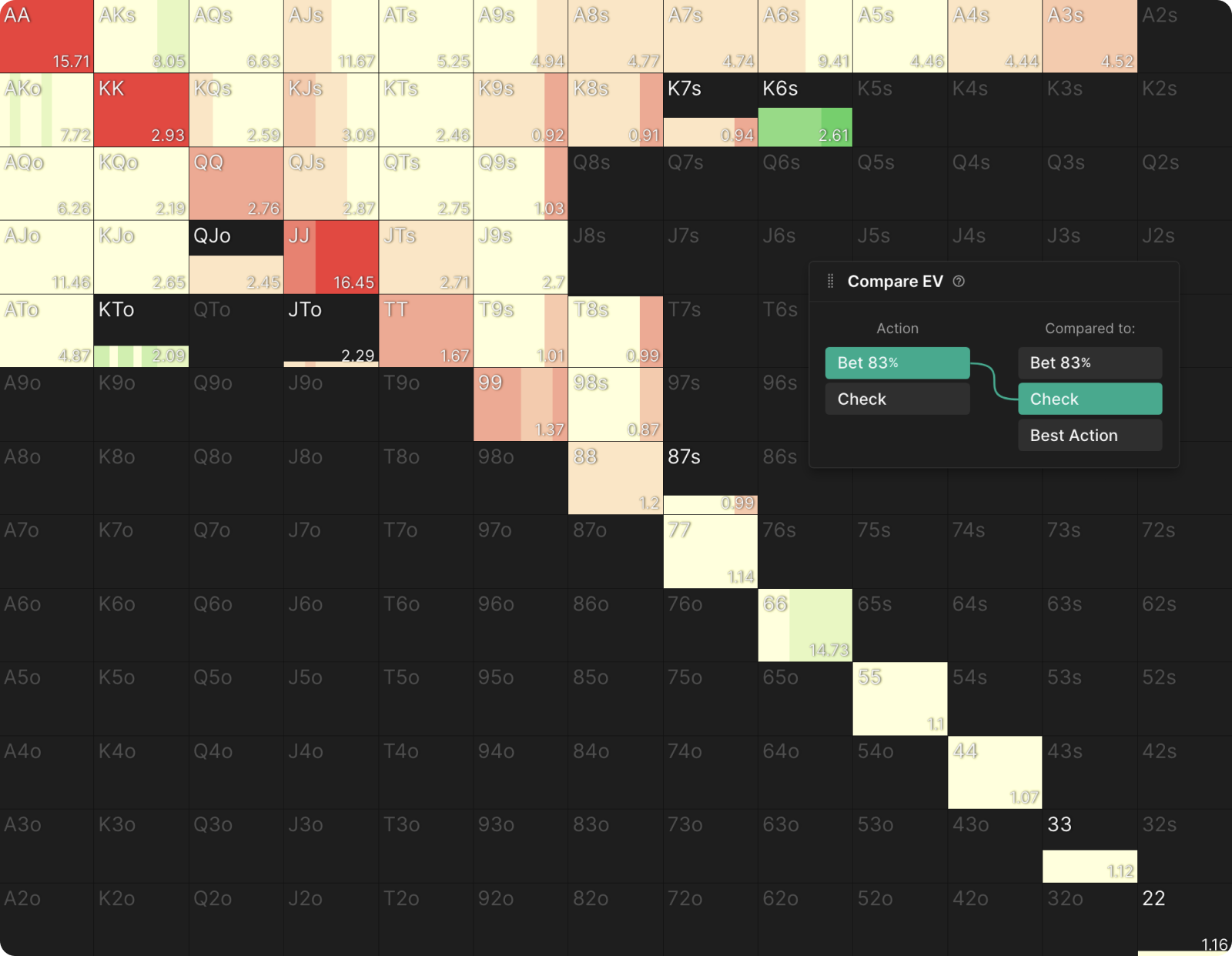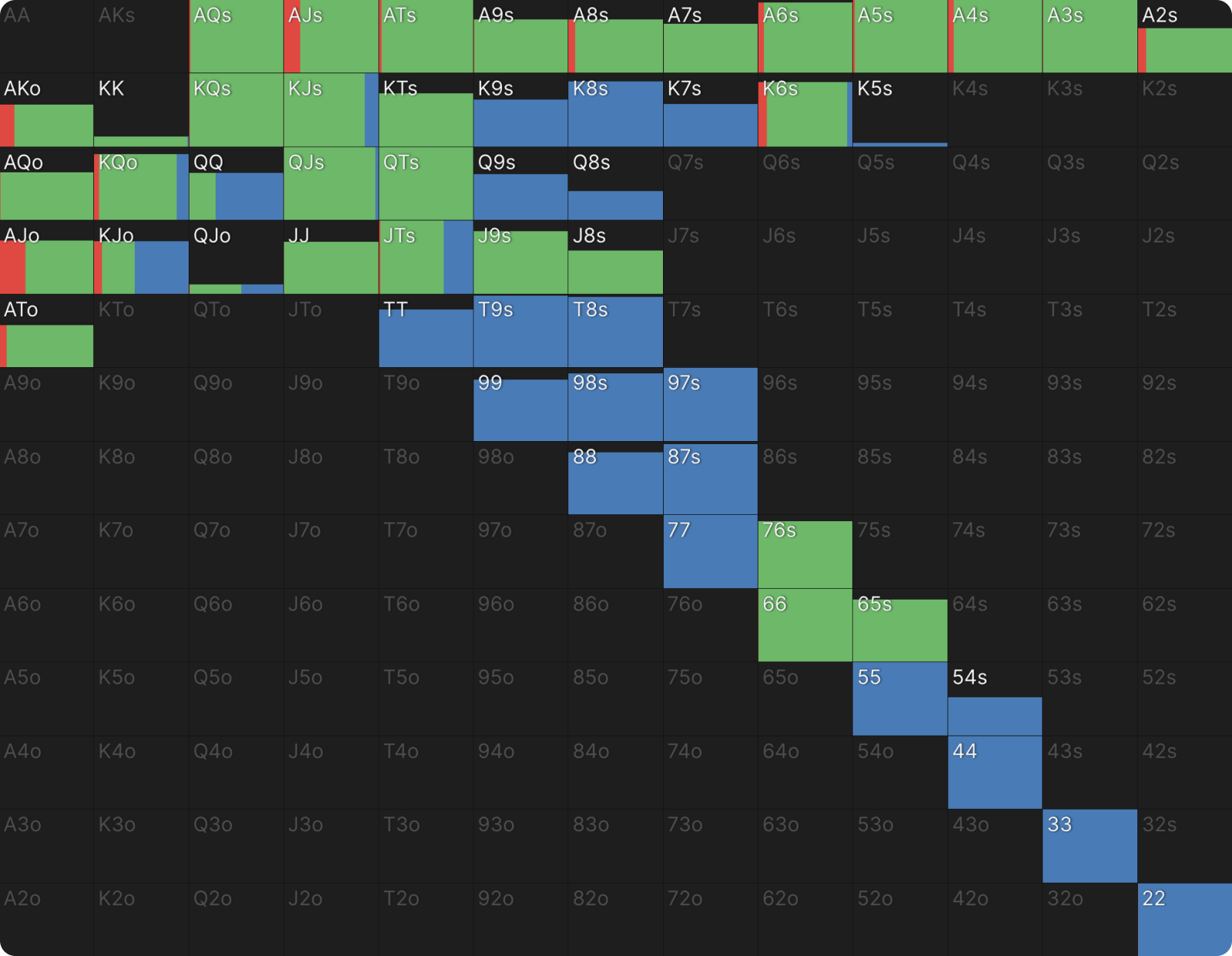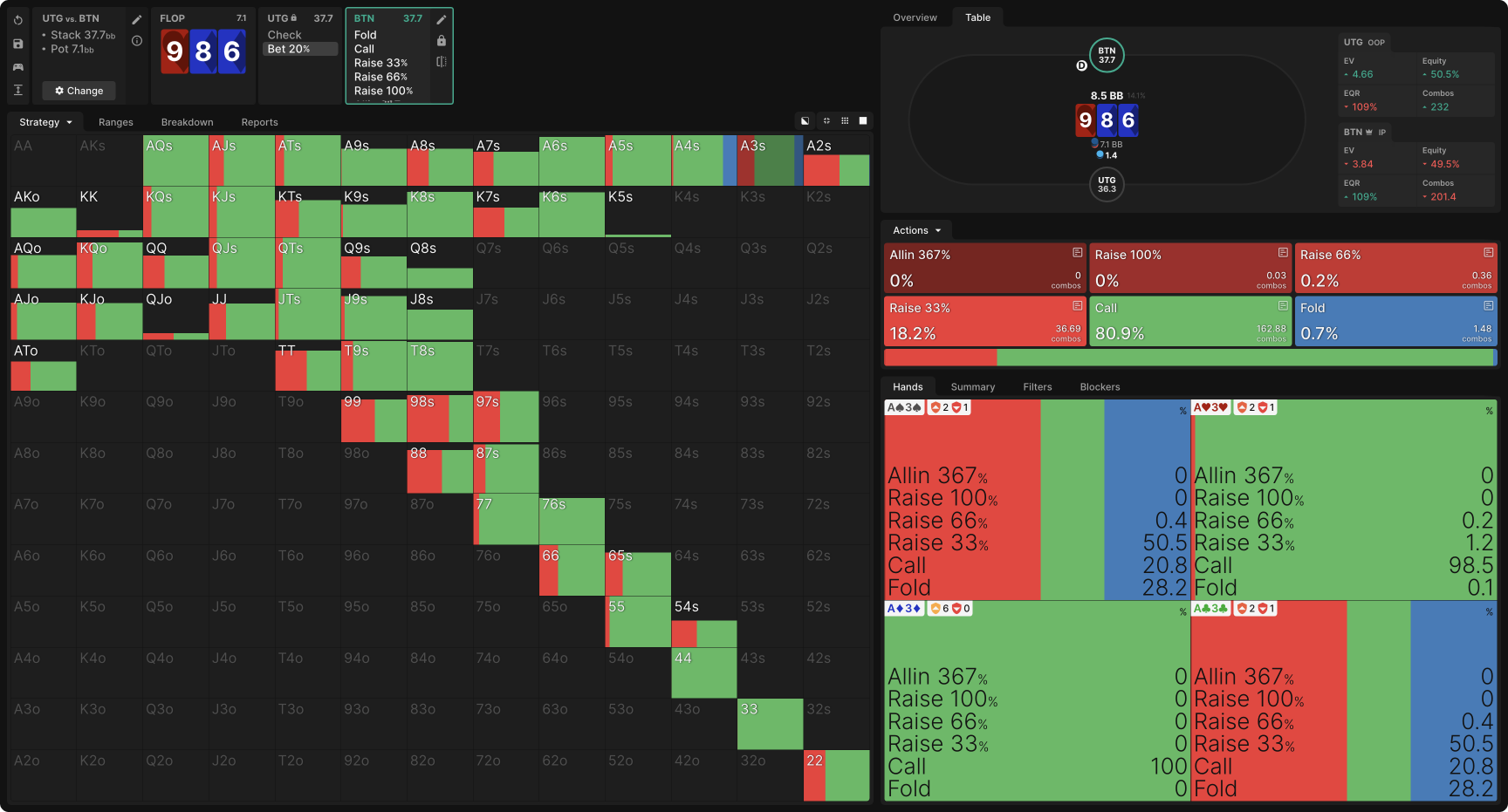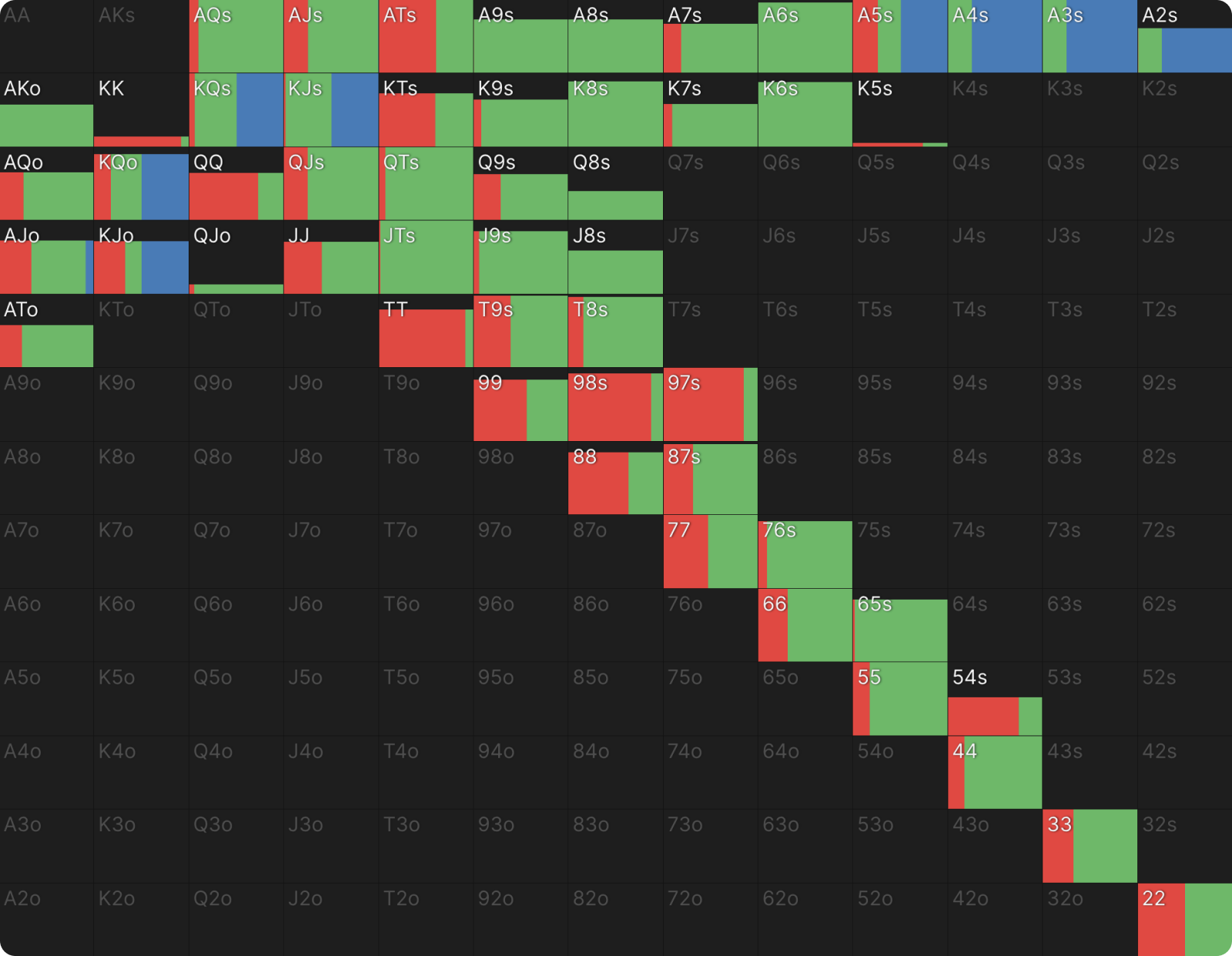Exploiting Excessive C-Betting by OOP
A preflop raiser who continuation bets too often is always a potential target for exploitation, but the best opportunities to profit from their mistakes emerge when they are out of position (OOP). From out of position, it is both easier to overdo and more expensive to bet the flop too often into a preflop cold caller. If you are the in position (IP) caller, understanding how to take maximum advantage of this mistake will serve you greatly.
There are some competing heuristics at play here. On the one hand, experiments with playing OOP suggest that raising is the best exploit, as it denies equity to the opponent’s lighter bets. On the other hand, the IP player generally does better letting the hand play out on later streets, where they will have the positional advantage, rather than ending it on the flop.
In this article, we will conduct some experiments to help you reconcile these competing heuristics and take maximum advantage of the opportunity created by an excessive continuation bettor when you have position on them.
A Static Flop
Static flops are less bad for the OOP player. They aren’t good—being out of position is always a liability—but they are less bad. Static boards make it easier for players to predict the strength of their hand on the river and bet accordingly.
Static flops are less bad for the out of position player.
In a 40bb single-raised pot between UTG and BTN, the pre-solved simulation gives UTG an EV of 3.95bb on an A♠J♥6♦ flop, nearly 56% of the pot. They continue to bet more than 70% of the time, strongly preferring a small size:
BTN responds to these small bets mostly by calling. They fold occasionally, but not enough to make any two cards a profitable bet for UTG. Here’s their response to a 20% pot bet, UTG’s most commonly used size:
Despite UTG’s preference for checking 28% of the time, forcing them to bet 20% pot with their entire range costs them just 2bb/100 in EV.
BTN’s response does not change dramatically, either. They call even more often, with both some hands that raise against the more balanced bet and some hands that fold to it:
For the out of position player, a small bet is not much different from a check. Both put very little money into the pot and run the same risk of the opponent choosing to charge a higher price to see the turn. This is a big difference from being in position, where a check guarantees a free turn while a bet reopens the action for the opponent to raise.
For the out of position player, a small bet is not much different from a check.
So, betting small at too high a frequency is not a huge liability for the OOP player. It could even be a winning strategy if the IP player folds too often. Even on boards that appear to favor the raiser, you should be extremely stubborn against such bets.
Larger Bets
In a simulation where UTG is only allowed to bet 83% pot or check, BTN plays an even more strict call-or-fold strategy in response to a bet:
This restriction does not cost UTG much EV. Though they almost always used a much smaller size in the unrestricted simulation, they do just 3bb/100 worse when restricted to this larger bet.
The option to check, however, is much more important to them when a big bet is the alternative. UTG bets only about ⅓ of the time at equilibrium, and when forced to range-bet with a 83% pot size bet, they lose nearly 40bb/100! If BTN exploits correctly, that is.
BTN’s folding frequency goes down a bit, but the big change to their strategy is a renewed interest in raising:
When given the option to check, UTG’s betting range is polar, as it should be for a large bet size:
A raise would merely result in them folding their worst hands, which have poor equity anyway, and continuing the strong ones, against which even BTN’s stronger hands might not be in good shape. Medium-strength hands are the ones that would face tough decisions when raised, but UTG isn’t betting those anyway.
But if UTG does bet those medium-strength hands, then raising becomes appealing for BTN. The ‘Compare EV’ display helps us visualize which hands are the worst to bet:
Thanks to their strong blocking effects on second-best hands, top and middle sets are actually the worst hands for UTG to bet! Bottom set, 66, unblocks their calling range and is a great value bet. But aside from those, the worst hands to bet are all medium-strength hands: middle pair, pocket pairs, top pair with a weak kicker, etc. These hands all hate getting raised.
Some humans are more concerned with winning the pot than maximizing their EV.
Is it realistic to think a human in UTG’s seat might bet these for a large size? As with any exploit, it depends on the player. There are certainly players out there who will bet to “represent the Ace” or to “take it down now” when they have a medium pair. Essentially, they are more concerned with winning the pot than maximizing their EV.
You’ll have to make a judgment call as to how well this applies to any given opponent, but it’s helpful to have such a specific question to focus your thinking. “Will this player bet medium-strength hands like KK here?” is a more specific and thus a more useful question than “Will this player bet too often?” since not all hands lose a lot of EV from betting at a higher frequency or from getting raised.
BTN’s exploitative raising range is mostly linear. The closest thing to a pure bluff is 54s, which in addition to its backdoor draws (5♣4♣ never raises), unblocks UTG’s weaker hands in a way that other backdoor draw hands like T9s do not. Other than that, the lighter raises are hands like middle pair, bottom pair with a good kicker, and big gutshots like KQ which also have overcards to middle pair.
On a static board that favors the OOP raiser’s range, betting too often is not necessarily a big mistake, even if it’s a large deviation from the equilibrium strategy. The most important thing for their opponent is to call stubbornly against their small bets and force them to play OOP on later streets. If they bet too often, they’ll lose a small fraction of those bets, which they could have saved by checking.
If they bet too often and too large, then big exploits become possible. It’s still correct for their opponent to fold more often, as the raiser has a lot of equity. But when they do continue, they should consider raising, which will put the bettor’s medium hands—the ones they really shouldn’t have bet in the first place—in a tough spot.
A Dynamic Flop
Dynamic flops are where excessive continuation betting really becomes a liability. In a 40bb single-raised pot between UTG and BTN, the GTO solution gives UTG an EV of 3.36bb on 9♥8♦6♦, which is less than half the pot. They continue to bet about 35% of the time, mostly for either 33% or 55% pot:
Dynamic flops are where excessive continuation betting really becomes a liability.
We have already seen that if a player is going to continuation bet too often, small bets are the safest way to do that. This will be true even though 20% pot is not much used when other options are available. Check is the most used option, so if that is not allowed, then 20% pot will be the next best thing.
Restricting UTG to checking or betting 20% pot is not, in and of itself, a big liability. It reduces their EV by 3bb/100, and importantly, it does not increase their betting frequency. They still prefer to check about twice as often as they bet.
BTN virtually never folds to this small bet. It’s hard not to have equity on this board, and they can anticipate very high equity realization on later streets thanks to their positional advantage.
Forcing UTG to bet 20% pot with their entire range reduces their EV by another 7bb/100, a full 10bb/100 less than what they had in the pre-solved simulation. Against this wider betting range, BTN never folds. They have a significant raising range, but calling remains the predominant option:
There’s some thin value/protection in the raising range, but this is also where some of the very worst hands, the rare folds at equilibrium, end up when UTG bets too often. Very few hands whiff this board entirely, but even the ones that do, like A♠3♠, can either bluff immediately or float and bluff turns when checked to. UTG simply has too many weak hands on this board.
Larger Bets
Restricting UTG to either checking or betting 50% pot doesn’t hurt their EV since this was roughly the bet size they preferred to use anyway. BTN raises even less often against this larger bet and, of course, folds more:
If UTG is forced to range-bet 50% pot, however, their EV is shredded. It drops to 3.12bb, a loss of 24bb/100 relative to their equilibrium strategy. As before, BTN exploits mostly with the introduction of raises to attack the middle of BTN’s betting range, which consists of overcards without significant draws:
For BTN, floating or bluff raising their very worst hands is too expensive against this larger bet, but their standards are low. Two overcards with a backdoor flush draw are enough to contest the pot:
The most important raises are not the bluffs but the thin value/protection hands, most notably the overpairs. For these hands, raising is a win-win proposition: they are strong enough to get action from worse, but they also benefit from folding out live overcards.
Other Exploits
When in the BB, consider calling wider than you otherwise would against a player you expect to continuation bet too often. That mistake will increase the EV of every hand in your range so that a few that would normally play slightly better as folds or raises would end up more profitable as calls.
Technically, the same is true when you have position on the raiser. If they continuation bet too often, your EV goes up, so some hands you would otherwise fold or raise could play better as calls. The complication is that, unlike in the BB, you aren’t closing the action. Other players could still call or raise behind you, and they will have extra incentive to do so if they suspect you are calling wider than usual.
Unless you are exactly on the BTN, I would advise against expanding your in-position calling range. Even when on the BTN, it’s best with passive, unobservant blinds.
Conclusion
The worse the board is for the preflop raiser, the more of a mistake it will be for them to continuation bet at a high frequency, especially if they also size their bet too large. A board being worse for them can mean one or both of two things:
The best candidates for these “extra” raises are not your worst hands but rather the middle of your range, hands that might otherwise have called against a less aggressive opponent. Much like AK before the flop, these hands benefit from folds while still performing reasonably well against calls. Bluff raising could easily be profitable as well, but it requires your opponent to make the additional mistake of overfolding, which is easier to do after betting too many weak hands.
Finally, it is important to understand the theory behind why donk betting is a mistake if your opponent will continuation bet too often because it gets at a more general point about exploitation. If you expect your opponent will make a mistake at some future node in the game tree, you have extra incentive to adapt your play at earlier decision points to increase the likelihood your opponent will end up in the situation where they are likely to make the mistake you intend to exploit.
- Their range has less equity.
- The board is highly dynamic, amplifying their positional disadvantage.
Each of these factors makes it less likely the raiser will win the pot, which makes growing the pot less desirable for them. Medium card flops tend to tick both these boxes, pairing more of the cold caller’s range while making very few hands so strong that they can be confident of their strength without regard for the turn and river cards.
A player who continuation bets too often on these boards will lose a fair bit even if you do nothing to exploit them, simply because they are putting too much money into pots relative to their chance of winning them. You can turn the screws by folding even less than you normally would—floating with any kind of equity is especially effective on such boards—and, if you suspect they are betting too many medium-strength hands, developing a raising range as well.
It’s best to think of these raises in terms of thin value, protection, and semi-bluffs rather than as flat-out bluffs, which are generally not profitable unless you also suspect your opponent will fold too often.
Author
Andrew Brokos
Andrew Brokos has been a professional poker player, coach, and author for over 15 years. He co-hosts the Thinking Poker Podcast and is the author of the Play Optimal Poker books, among others.

































































































































































































































































